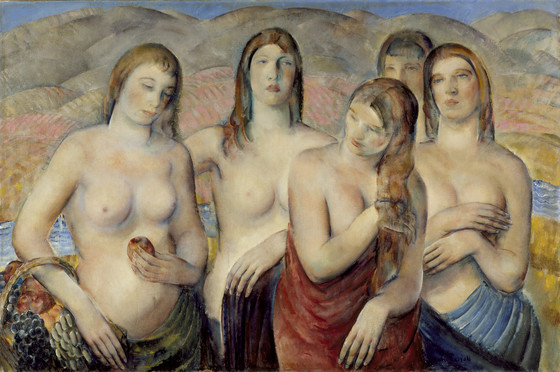Throughout his career Carroll was fondest of painting the female figure, especially the nude. Parthenope served as a vehicle for the artist’s exploration of progressive ideas....
Throughout his career Carroll was fondest of painting the female figure, especially the nude. Parthenope served as a vehicle for the artist’s exploration of progressive ideas. Indeed, it was the painting’s modern character that attracted attention when it was exhibited at the Los Angeles Museum in the First Pan-American Exhibition of Oil Paintings in 1925-26. At that time controversy arose over whether the coveted Balch prize should be given to a conservative or a modern painting. The result was a compromise, with the award being shared between Where Nature’s God Hath Wrought, 1925 (LACMA; q.v.), by WILLIAM WENDT and Parthenope. Consequently Carroll’s painting received much attention from the press. Most critics appreciated his harmonious color and fluid line. Antony Anderson of the Los Angeles Times wrote, "never was rhythm of line and form more alluringly rendered," and Vennerstrom Cannon of the La Jolla Journal thought it remarkable and worth the excursion to Los Angeles. Others could not comprehend Carroll’s modernism, one critic referring to his "haulking maidens" set against "sausage-like hills." It was even parodied in comic versions created for the annual fakir celebration of the California Art Club. E. Roscoe Shrader referred to his version which also appeared as a cartoon in a local newspaperas Bare ’n’ Soapy, portraying the maidens as women taking a shower and attaching an actual shower nozzle and soap dish to the canvas.
Parthenope exemplifies certain aesthetic and pseudoscientific ideas held by progressive artists during the period. Carroll’s tendency to simplify his figures into solid geometric shapes recalls similar neoclassical figures painted in the 1920s by the purists and Pablo Picasso (1881-1973). Since Carroll usually focused on a single figure, he may have felt the need for a theoretical basis for the design of this, his most complex figure composition. To assure a wellproportioned and harmonious arrangement, Carroll constructed the composition on the design principles of the "whirling square rectangle" as propounded by Jay Hambidge (1867-1924) and his disciple George Bellows. The arrangement of figures across the foreground plane and the placement of their arms and headsespecially those of the woman at center with tilted head and shoulders-accords precisely with Hambidge’s theory, in particular his emphasis on diagonals to create controlled, rhythmic movement. The arcing lines of the softly rolling, distant mountains repeat the curves and rhythms of the figures’ anatomy and drapery. Such a treatment of the landscape, although idealized, is similar to that in Bellows’s Woodstock landscape with figures, Picnic, 1924 (Peabody Institute of the City of Baltimore), which also was based on Hambidge’s theory of dynamic symmetry.
Hambidge’s concept was founded on principles expounded by the ancient Greeks, and this classical origin may have encouraged Carroll’s use of a classical motif. There are several legends about Parthenope, in one of which she is a siren who, with her sisters, threw herself into the sea, which many have been Carroll’s inspiration. Such an allusion to antiquity and the idealized presentation were not typical of Carroll’s art.
Antony Anderson referred to the painting’s "synchronism [sic] of color," and its rainbow effect suggests that Carroll may have applied to Parthenope some of the pseudoscientific color theories then popular. The drape of each of the three foreground figures is painted a single intense hue-red, blue, or green-and these colors as well as the yellow in the middle distance constitute the painting’s palette. Carroll merely added white to create pastel tints for the background and skin. Even the short, striated brushwork in the background suggests that he sought to present his colors as if seen through a prism.
More...
